Модулирующее влияние адреналина на развитие стероидной миопатии у белых крыс, индуцированной длительным введением гидрокортизона
DOI:
https://doi.org/10.25557/IGPP.2017.4.8530Ключевые слова:
скелетная мышца; гидрокортизон; гиперкортицизм; стероидная миопатия; адреналин.Аннотация
Цель исследования — изучение эффективности адреналина в компенсации негативных эффектов длительно вводимого гидрокортизона на скелетную мышцу смешанного типа. Методика. Эксперименты проводились на половозрелых крысах-самках (190—220 г), разделенных на 3 группы: контрольную (n = 10), I опытную (n = 10, ежедневно на протяжении 30 сут. получали гидрокортизона ацетат, Г-группа) и II опытную (n = 10, ежедневно на протяжении 30 сут. получали гидрокортизона ацетат в комплексе с адреналина гидрохлоридом, (Г+А)-группа). Гидрокортизона ацетат («Фармак», Украина) вводили внутрибрюшинно в дозе, адекватной терапевтической для человека, — 3 мг/кг. Адреналина гидрохлорид («Здоровье», Украина) вводили подкожно в дозе 0,2 мг/кг. На наркотизированных животных (тиопентал натрия, 100 мг/кг) с помощью методов электромиографии и миографии изучали параметры функционального состояния передней большеберцовой мышцы в условиях ее сокращения, индуцированного раздражением сверхпороговым электрическим током малоберцового нерва. Результаты. Длительное (в течение 30 сут.) введение гидрокортизона вызывало развитие симптомов стероидной миопатии, о чем свидетельствует появление низкоамплитудных М-ответов нормальной длительности, возрастание частоты полифазных потенциалов (до 30%), уменьшение количества активируемых двигательных единиц (на 33%) и мышечной массы (на 14%). Гидрокортизоновый гиперкортицизм сопровождался удлинением латентного периода одиночного сокращения передней большеберцовой мышцы (на 37%) и фазы его укорочения (на 20%), уменьшением амплитуды одиночных сокращений (на 32%), объема выполненной мышцей внешней работы (на 40%) и развиваемой мощности (на 41%) при тетаническом сокращении. Отмечены нарушения в целостном процессе нервно-мышечной передачи, что проявлялось в уменьшении степени ее надежности (у 30% особей), выраженном облегчении (более 85% у 50% особей) или депрессии (до -42% у 40% особей) при стимуляции нервно-мышечного аппарата с оптимальной частотой (30 имп/с). Адреналин, вводимый в комплексе с гидрокортизоном, предотвращал появление ряда симптомов миопатии, таких, как снижение амплитуды М-ответов, уменьшение количества активируемых двигательных единиц мышцы, ее массы, внешней работы и мощности, а также обусловливал уменьшение частоты генерации полифазных М-ответов (с 30% до 10%). Кроме того, адреналин ослаблял негативный эффект гидрокортизона на синаптический аппарат, что проявлялось в уменьшении частоты встречаемости сниженной надежности синаптической передачи (с 30% до 10%), выраженного ее облегчения (с 50% до 20%) и депрессии (с 40% до 10%) у животных (Г+А)-группы в сравнении с Г-группой. Заключение. Полученные в модельных экспериментах на животных в условиях in situ данные свидетельствуют о способности адреналина эффективно компенсировать ряд негативных эффектов, развивающихся в скелетной мышце при длительном введении гидрокортизона.Загрузки
Опубликован
2017-12-18
Выпуск
Раздел
Оригинальные исследования
Как цитировать
[1]
2017. Модулирующее влияние адреналина на развитие стероидной миопатии у белых крыс, индуцированной длительным введением гидрокортизона. Патологическая физиология и экспериментальная терапия. 61, 4 (Dec. 2017), 104–111. DOI:https://doi.org/10.25557/IGPP.2017.4.8530.













